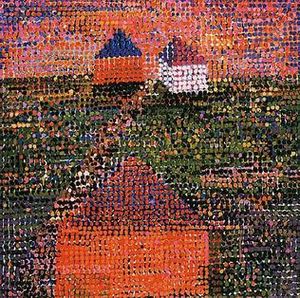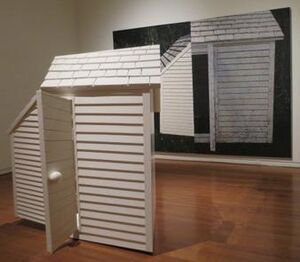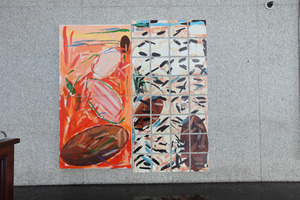Jennifer Bartlett facts for kids
Quick facts for kids
Jennifer Bartlett
|
|
|---|---|

'Houses', serigraph by Bartlett, 2005
|
|
| Born |
Jennifer Losch
March 14, 1941 Long Beach, California, U.S.
|
| Died | July 25, 2022 (aged 81) Amagansett, New York, U.S.
|
| Education |
|
| Known for | Painting |
Jennifer Bartlett (born Jennifer Losch; March 14, 1941 – July 25, 2022) was a famous American artist. She was known for her unique paintings and prints. Her art often mixed the careful planning of conceptual art with the expressive style of Neo-Expressionism. Many of her artworks were made on small, square steel plates covered in enamel. She would put these plates together in a grid to create very large pieces.
Contents
Growing Up and Learning Art
Jennifer Losch was born in 1941 in Long Beach, California. She was one of four children. Her dad owned a construction company, and her mom was a fashion illustrator. Her mom later stopped working to raise her children. Jennifer grew up near the ocean and loved water. This love for water later showed up in her art.
College Years and Early Influences
She went to Mills College in Oakland, California, and earned her degree in 1963. While in college, she met Elizabeth Murray, who became a close friend for life. After Mills College, Jennifer moved to New Haven, Connecticut to study at the Yale School of Art and Architecture. At that time, a style called minimalism was very popular. Minimalism focused on simple shapes and colors.
She studied with famous artists like Josef Albers and Jim Dine. She earned her Master of Fine Arts degree in 1965. Jennifer said that studying at Yale was her biggest influence. She felt like she "walked into her life" there. She also mentioned that as a young art student, she was thinking about becoming an artist, listening to music, and reading books by authors like Albert Camus. She had always loved to draw, especially sea creatures and fairytale characters. Some of her early art inspirations included Arshile Gorky and Piet Mondrian.
Exploring Her Art Style

Jennifer Bartlett was best known for her paintings and prints. She often painted everyday things like houses, gardens, oceans, and skies. Her style blended both realistic and abstract art. She believed there was no real difference between these two styles.
She often created art in a series or made polyptychs, which are artworks made of several panels. She also liked to set up rules for how she would create variations within a group of works. This made viewers think about how they see things and how their minds work. In the late 1960s, she started adding chance elements to her art, inspired by the composer John Cage.
Common Subjects and Collections
Jennifer often painted simple subjects like ordinary houses. Her art installations sometimes included many canvases and even 3D objects. For example, her 1988 piece House with Open Door includes a painting of a house and a real wooden house.
Her art is displayed in many major museums. These include the Dallas Museum of Art, the Metropolitan Museum of Art, the Museum of Modern Art (New York City), and the Tate Modern.
Most art critics thought Jennifer's work was creative and full of energy. They saw her as one of the top painters of her time. Some critics noted that she used the structured grid, common in conceptual art, to create emotional and expressive images. A few critics found her work to be too focused on surface or too varied. She had several big art shows over the years, including one in 1985 at the Brooklyn Museum and another in 2014 at the Parrish Art Museum.
Early Experiments with Materials
Early in her career, Jennifer made some 3D artworks that she would freeze or smash. She also wanted a surface to draw on that was gridded like graph paper but could be erased. This led her to use her signature material: foot-square steel plates. These plates had a plain white baked enamel surface with a quarter-inch grid printed on them. She had many of these made and later used other sizes too.
Famous Art Series
The Rhapsody Project (1975–76)
One of Jennifer Bartlett's most famous early works is Rhapsody. It's a huge painting made on 987 foot-square steel tiles. These tiles are arranged in a grid that is 7 plates tall and about 142 plates wide. It stretches across several walls. The artwork explores basic art elements like four main motifs (house, tree, ocean, mountain), geometric shapes (line, circle, triangle, square), and 25 shades of color.
Rhapsody was a huge success and surprised the art world. It combined different art styles like photorealism and abstract art. It was so big that Jennifer said she never saw the whole piece until its first public show. She said it "opened the wall up" and looked bigger than it was. The Museum of Modern Art in New York now owns Rhapsody.
At Sea, Japan (1980)
In 1980, Jennifer worked with master printers in Japan on a complex print project. The result was At Sea, Japan, a waterscape printed on paper. It has 6 panels and is 8 feet wide. The image was created using 96 screenprints and 86 color woodcuts.
The In the Garden Series (1979–83)
The In the Garden series includes over 200 drawings, and later paintings and prints. All of these artworks show the garden behind a villa in Nice, France, where Jennifer stayed in 1979–1980. The drawings vary from simple pencil sketches to colorful pastels and gouaches. Many are diptychs (two panels) or triptychs (three panels). Later, she made a similar series focusing on her own backyard garden in Brooklyn, New York.
Sea Wall (1985)
With Sea Wall, Jennifer combined oil painting and sculpture. This piece features a large painting of houses and boats on a dark background. In front of the painting, there are sculptural versions of those same houses and boats.
Digital Painting (1987)
In 1987, the BBC invited Jennifer to try digital painting using a special computer program called a Quantel digital Paintbox. She was one of six international artists, including David Hockney. At first, she wasn't sure about it, but she grew to enjoy this new way of creating art.
Air: 24 Hours (1991-92)
This project was a collaboration between Jennifer Bartlett and writer Deborah Eisenberg. It first appeared as a book with 24 paintings by Jennifer and text by Deborah. Each painting shows a scene in Jennifer's house at a different hour of the day.
The Amagansett Series (2007–08)
The Amagansett series is a collection of oil paintings. They show the ocean, skies, and seaside views of Long Island. These paintings use a unique cross-hatched style and a limited color palette, mostly blues, greens, grays, and browns. Some pieces are diptychs, where Jennifer explores how a landscape changes between two moments or from two slightly different views.
Art for Public Spaces
In 1981, Jennifer created Swimmers Atlanta, a 200-foot-long multimedia mural for the Federal Building in Atlanta, Georgia. She also completed art projects for companies like Volvo and AT&T, and for places like Battery Park in New York City.
Personal Life and Passing
Jennifer married Ed Bartlett, a medical student, in 1964. She taught at the University of Connecticut while living between New York City and New Haven, Connecticut.
After her divorce in 1972, Jennifer moved to New York City full-time. She began teaching at the School of Visual Arts. In 1983, she married German actor Mathieu Carrière. They had a daughter named Alice, but later divorced in the early 1990s. She lived in New York City and Paris. By 2014, she lived full-time in Amagansett, New York on Long Island.
Jennifer Bartlett passed away from acute myeloid leukemia at her home in Amagansett on July 25, 2022. She was 81 years old.
Selected Art Shows
- Paula Cooper Gallery, New York, 1976. Rhapsody.
- Whitney Museum of American Art, New York, 1978. New Image Painting.
- Clocktower Gallery, New York, 1979.
- Whitney Biennial, 1981.
- Walker Art Center, Minneapolis, MN, 1984.
- Brooklyn Museum, New York, 1985. 15 Year Retrospective.
- Walker Art Center, 1986.
- Orlando Museum of Art, 1993.
- Locks Gallery, Philadelphia, 1994. Recent Works from the AIR: 24 Hours Series.
- Locks Gallery, Philadelphia, 2000. Islands and Oceans.
- Locks Gallery, Philadelphia, 2004. At Sea.
- Addison Gallery of American Art, 2006. Early Plate Work.
- Pace Gallery, New York, 2011. Recitative (2009–10).
- Locks Gallery, Philadelphia, 2011. The Studio Inside Out.
- Museum of Modern Art, New York, 2011. Rhapsody and other works.
- Locks Gallery, Philadelphia, 2012, Addresses (1976–1978)"
- Locks Gallery, Philadelphia, 2013, Chaos Theory
- Parrish Art Museum, 2014. Jennifer Bartlett: History of the Universe — Works 1970–2011.
- Locks Gallery, Philadelphia, 2015. In the Garden
- Paula Cooper Gallery, 2016.
Awards and Art in Museums
Jennifer Bartlett received the Francis J. Greenburger Award in 2019. She also won the American Academy of Arts and Letters Award in 1983 and the American Institute of Architects Award in 1986. She became a member of the National Academy of Design in 1990.
Her artwork is held in many important museum collections. These include the Metropolitan Museum of Art (New York), the Museum of Modern Art (New York), the Guggenheim Museum (New York), the Whitney Museum of American Art (New York), the National Gallery of Art (Washington, D.C.), and the Tate Gallery (London).
Her image is also part of the famous 1972 poster Some Living American Women Artists by Mary Beth Edelson.


